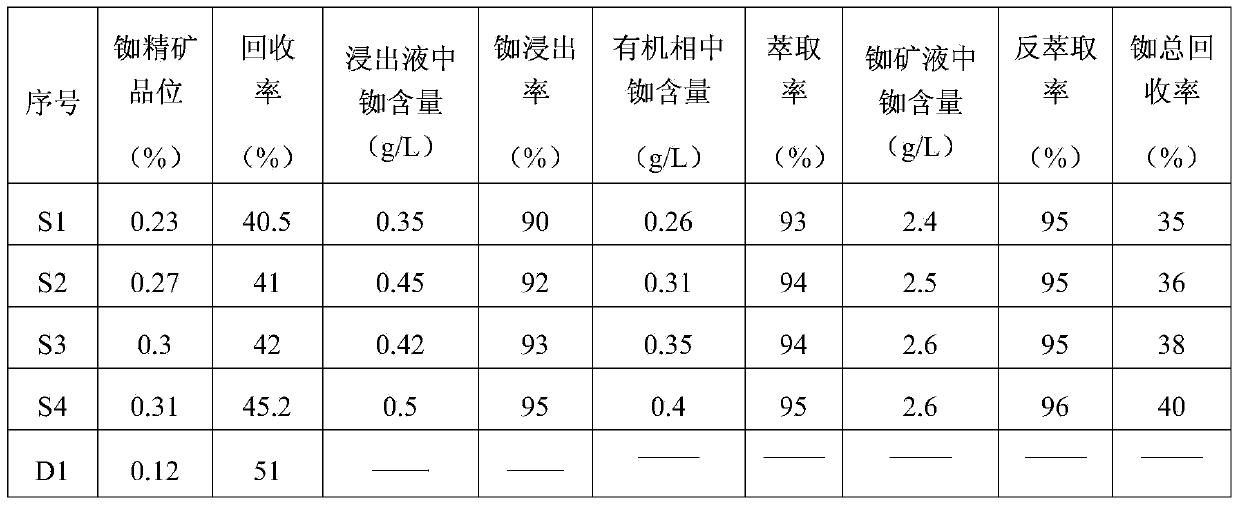Method for recycling rubidium from iron tailings
A technology of iron tailings and magnetic separation tailings, applied in the direction of improving process efficiency, etc., can solve the problems that tailings can only be used as building materials and the comprehensive utilization rate of iron tailings is low
- Summary
- Abstract
- Description
- Claims
- Application Information
AI Technical Summary
Problems solved by technology
Method used
Image
Examples
Embodiment 1
[0042] 1) Classification: Classify the iron tailings to obtain the first mineral of +10 microns;
[0043] 2) Flotation: Sequentially carry out sulfur removal flotation and recovery flotation on the first mineral to obtain rubidium concentrate; sulfur removal flotation: add 80g / ton to the magnetic separation tailings in sequence The butyl xanthate and 100g / ton pine alcohol oil are used for one rough cleaning and two sweeps, and then four blank separations are carried out to obtain sulfur concentrate and second tailings;
[0044] Recovery flotation: Slurry the second tailings to pH 2, add 400g / ton of water glass and collector in sequence, wherein the collector consists of 300g / ton of stearylamine acetate and 100g / ton of terpineol oil Composition, one rough sweep and two sweeps, followed by four blank beneficiation to obtain rubidium concentrate;
[0045] 3) Roasting: adding sodium chloride to the rubidium concentrate and roasting at 900°C to obtain a roasted product;
[0046] ...
Embodiment 2
[0048] 1) Classification: Firstly, the iron tailings are classified by a hydrocyclone to obtain -400 mesh minerals, and then the minerals are classified again to obtain the first minerals of +10 microns, and the rubidium grade in the first minerals is 0.015%.
[0049] 2) Magnetic separation: After the first mineral is slurried, a rough and a sweep magnetic separation is carried out, the magnetic field strength is 15000Gs, the tailings obtained are magnetic separation tailings, and the total iron grade in the magnetic separation tailings is 0.9%.
[0050] 3) Desulfurization flotation: Add 100g / ton of ethyl xanthate and 100g / ton of terpineol oil to the magnetic separation tailings in order to carry out a rough sweep and two sweeps, and then perform four blank separations to obtain sulfur concentrate and the second Second tailings;
[0051] 4) Recovery flotation: Slurry the second tailings until the pH is 2, add 400g / ton of water glass and collector in sequence, wherein the colle...
Embodiment 3
[0057] 1) Classification: Firstly, the iron tailings are classified by a hydrocyclone to obtain -400 mesh minerals, and then the minerals are classified again to obtain the first minerals of +10 microns, and the rubidium grade in the first minerals is 0.02%.
[0058] 2) Magnetic separation: After the first mineral is slurried, it is subjected to rough and sweep magnetic separation, the magnetic field strength is 18000Gs, the tailings obtained are magnetic separation tailings, and the total iron grade in the magnetic separation tailings is 0.8%.
[0059] 3) Desulfurization flotation: add 200g / ton of ethyl xanthate and 150g / ton of terpineol oil to the tailings of magnetic separation in order to carry out a rough sweep and two sweeps, and then carry out four blank separations to obtain sulfur concentrate and the second Second tailings;
[0060] 4) Recovery flotation: Slurry the second tailings to pH 3, add 800g / ton of water glass and collector in sequence, wherein the collector c...
PUM
 Login to View More
Login to View More Abstract
Description
Claims
Application Information
 Login to View More
Login to View More - R&D
- Intellectual Property
- Life Sciences
- Materials
- Tech Scout
- Unparalleled Data Quality
- Higher Quality Content
- 60% Fewer Hallucinations
Browse by: Latest US Patents, China's latest patents, Technical Efficacy Thesaurus, Application Domain, Technology Topic, Popular Technical Reports.
© 2025 PatSnap. All rights reserved.Legal|Privacy policy|Modern Slavery Act Transparency Statement|Sitemap|About US| Contact US: help@patsnap.com


